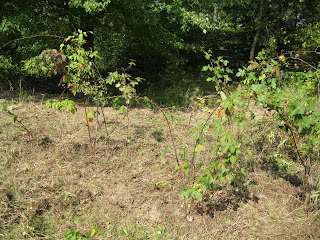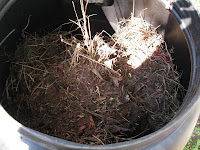An apple a day may keep the doctor away, but applesauce and apple butter make me happy. Ok that was corny... you try being witty after working with 100 pounds of apples. You heard that right, 100 pounds (technically 150 pounds, but 50 were for someone else). That is what we returned home from the U-pick with on Saturday. Locally Gala, Cortland and Honeycrisp were ready to pick.
Left to Right: Honeycrisp, Cortland, Gala
Honeycrisp are a relatively new apple, a cultivar created at a University. It is known for being firm with a sweet tangy flavor. I think they hold up really well to cooking, and although the growers say they are good for eating I prefer a sweeter apple for a snack. Be warned however, because Honeycrisp are a newer variety of apple they are more expensive than most other apples. At our U-pick they were $.30 more per pound. The Cortland is a hybrid apple which is a cross between a Mcintosh ( a tart apple) and something else and the result is an apple that is sweeter than the McIntosh but has the same firm white flesh. If you leave the skins on this apple will make pretty pink applesauce. The Gala is a very crisp apple with a sweet taste. These were also exceptionally juicy, dripping juice down our arms and we ate as we picked.
Our mission was to get some Honeycrisp apples while they were in season, but we ended up with Cortland and Gala as well. Most of the Galas are being saved for school lunches and snacks. The Honeycrisp and Cortland are being frozen and made into applesauce.
This brings us to the task at hand. Turning nearly 100 pounds of apples into product for the freezer. By special request we made a batch of apple butter which we will be enjoying for months to come. Apple butter starts with applesauce. You can use store bought sauce, but why would you when you have bushels and bushels of fresh apples on hand.
Applesauce is relatively easy. Cut and core the apples and cook until soft. Peel on or peel off is a matter of taste. I leave the peels on because I like the color that it gives to the applesauce; besides it is faster. I know of some people who steam their apples, I just boil mine. Enter - Bertha, my big stew pot.
We have another one that is even larger, fondly called Big Bertha. Since we are still cooking on the grill, Bertha had to do today.
Once the apples are cooked down to a soft texture (about fork smashable soft, you don't want mushy- be careful not to overcook) you are ready to process the apples with a food mill or sieve. I have a small 1 quart food mill, and growing up we used a large food sieve.
You can manipulate the texture of your applesauce by varying the size of the screen if you use a food mill. I prefer a smoother texture which is produced with themiddle screen on my food mill. The work goes faster with the larger screen and if you are going to proceed to apple butter you are going to blend it again anyway, so might as well save some effort.
Unless you like really sweet applesauce, you do not need to add any sugar/sweetener to the applesauce. The tarter the apple, the tarter the applesauce of course.
4 quarts of sliced apples makes about 1 quart of applesauce. Our apple butter recipe calls for 6 quarts of applesauce.
Before we get to the apple butter, here is a trick from my mom that is very handy. Air turns apples brown, and it will do the same to applesauce so you want to remove any air that is in the packaging prior to freezing your applesauce. If you are canning it, the first half of this trick will work for your jars.
Pour the applesauce into your bag (or jar) and tap the bottom of the container on the counter. This will cause any air bubbles inside to come to the surface (this works of cake and quick bread batter as well preventing those weird "tunnels" that show up when you bake). Then insert a straw into the bag of applesauce. Seal the zipper bag around the straw and squeeze out as much air as possible. Kneed the bag directing any remaining air bubbles towards the straw. Once you have all of the little air bubbles out remove the straw and completely seal the bag.
 |
| See the air bubbles? |
bounce the bag on the table to force the air bubbles to the surface
Squeeze the air out and pull out the straw
Lay the bags flat in the freezer. Once they are thoroughly frozen you can stand them side by side (like books on a shelf) to save space.
 |
left - Honeycrisp, peelsoff
center - Honeycrisp, peels on
right - Cortland, peels on |
You have been very patient, so here is the recipe for apple butter.
Homemade Apple Butter
You will need:
6 quarts applesauce, divided
3 cups sugar, divided
1 T ground cinnamon (or 4 cinnamon sticks)
1 t ground cloves ( or about 6 whole cloves)
(some recipes call for allspice in addition to the cinnamon and cloves, can't stand the stuff but I thought I would mention it for those who are adventurous)
Crock Pot
Pour 4 quarts of applesauce into the crock pot and add 1 1/2 C of sugar and all of the spice. Stir well. The applesauce will cook over night and reduce by half or more. I usually start cooking about 8pm on high for an hour or so and then reduce the heat for the overnight cooking. Do not cover the crockpot. It may splatter depending on the size of your crockpot so you can place the cover on loosely and vent it (put a spoon under one side) or use a splatter cover. In the morning (after about 12 hours of cooking) remove and skin that has formed on the top of the apple butter and discard. Stir the mixture well. It will be dark and thick (and should smell heavenly). Add the remaining applesauce and 1 cup of the remaining sugar and stir well. Do not panic when the consistency changes from looking like apple butter to looking like thick applesauce, you are going to cook this down again. Cook for an additional 2 hours. You are now ready to taste test your apple butter. You might want to add the remaining 1/2 of sugar if your apple butter is not sweet enough. If you add more sugar you are going to need to cook for another 1-2 hours to allow the sugar to dissolve and blend. You might want to put the cover on for this additional time depending on how thick your apple butter has gotten.
If you did not add additional sugar, you can decide on the texture you want. If you prefer a thicker apple butter you might want to cook longer. Using a stick blender or traditional blender process the apple butter until it has a smooth texture. If it thins out when you blend it, just leave the heat on for a while longer. If the texture seems right transfer to container, jar, or bag. In our case, the apple butter went straight from the crock pot to the breakfast table.


































